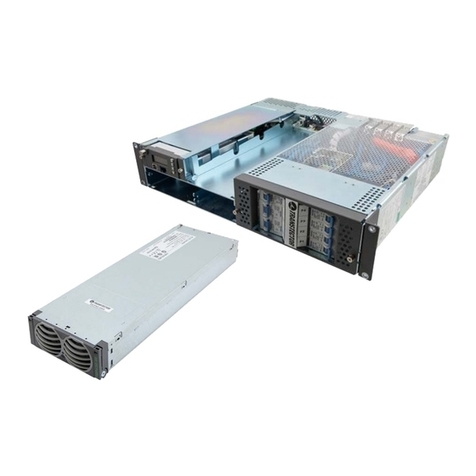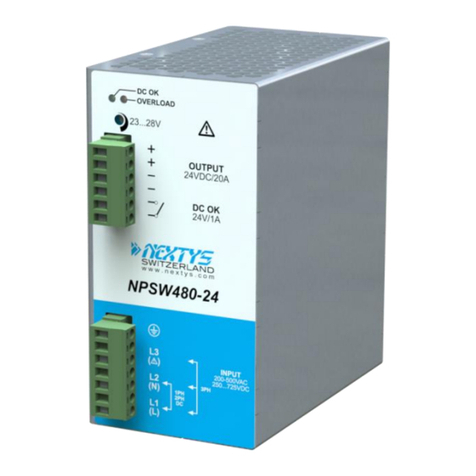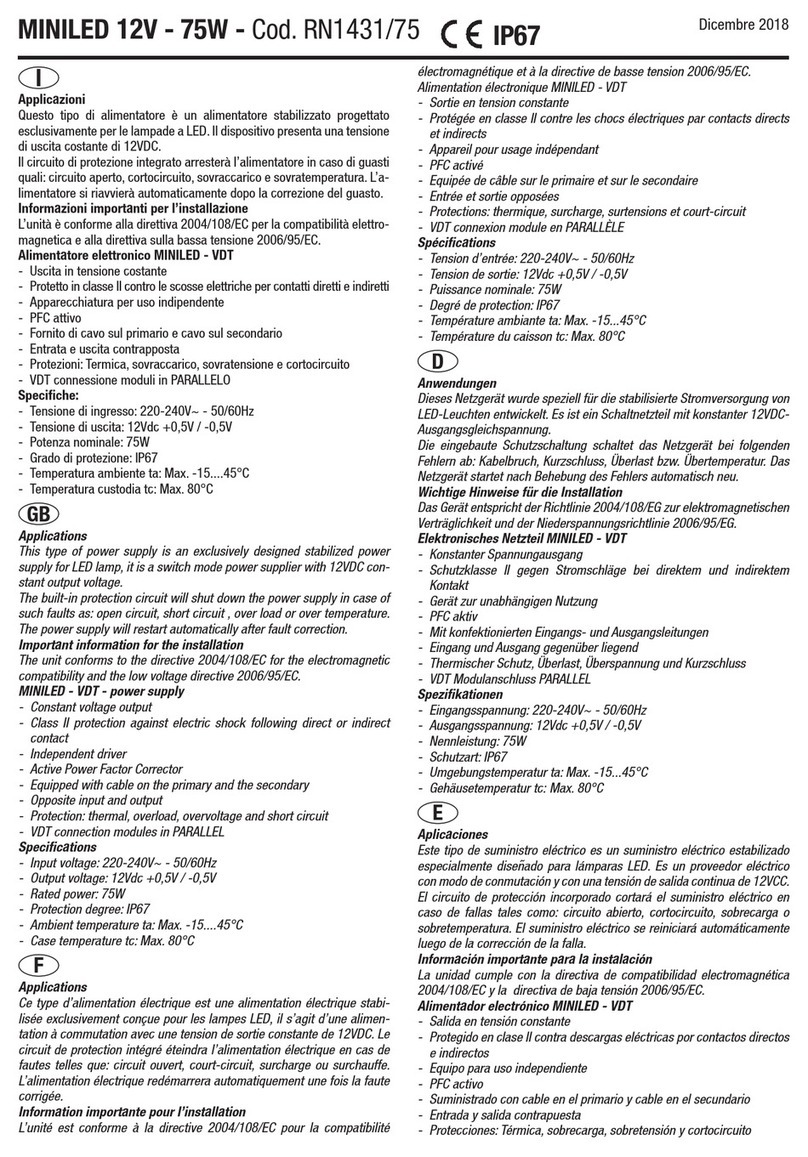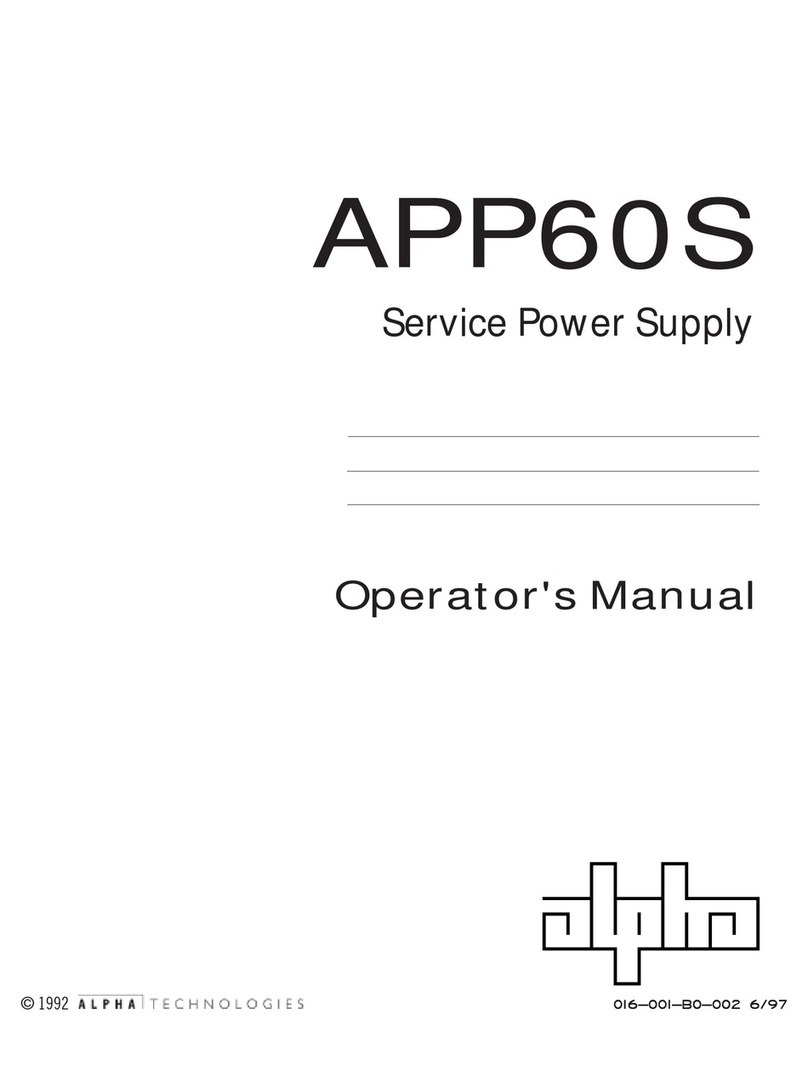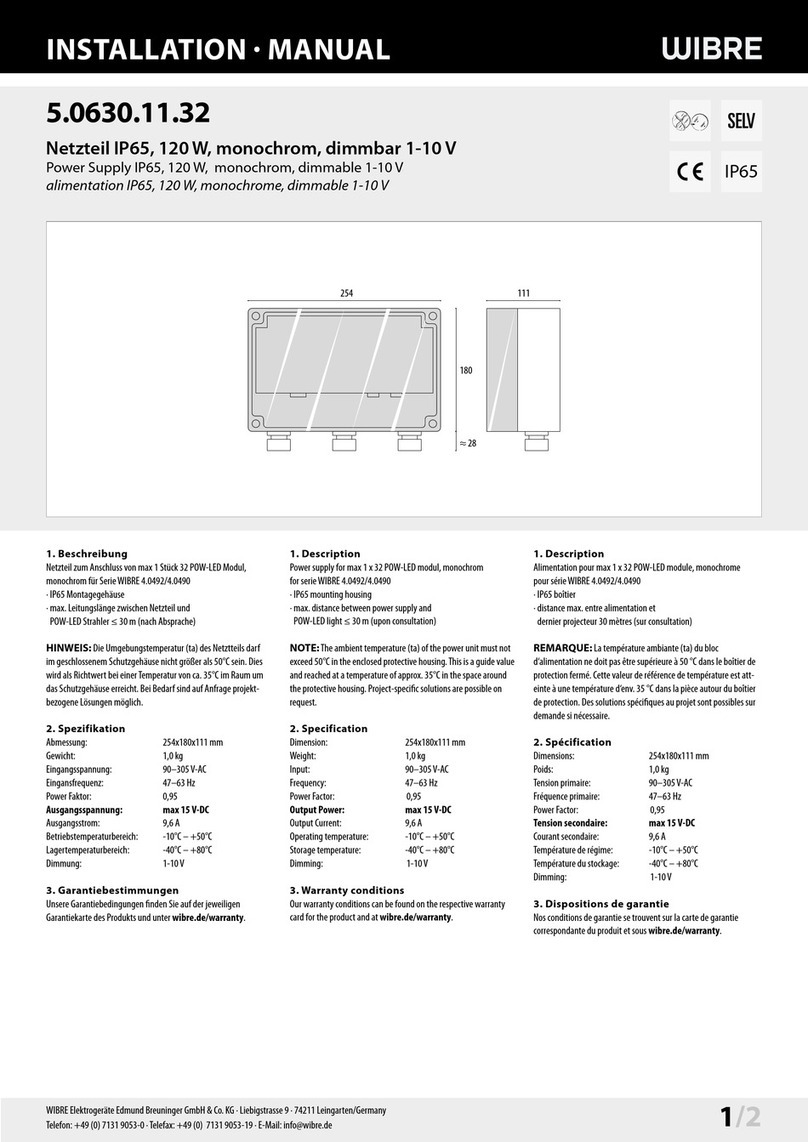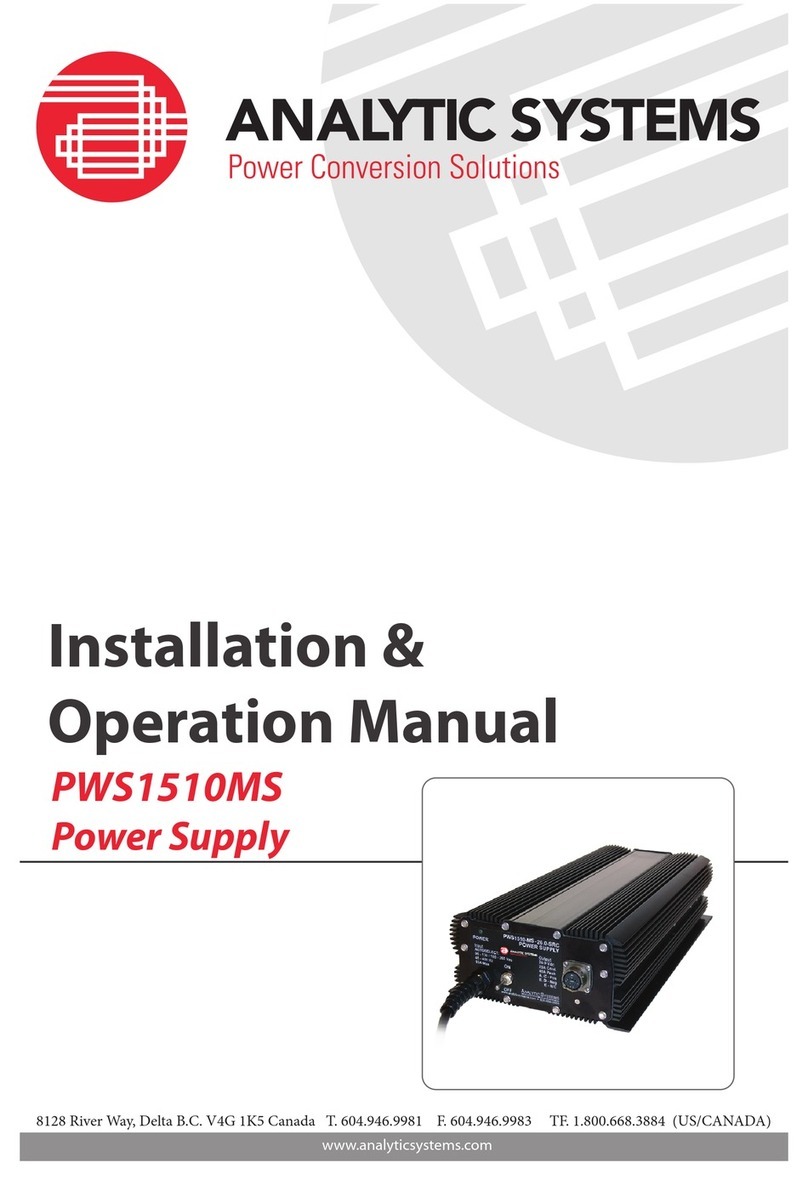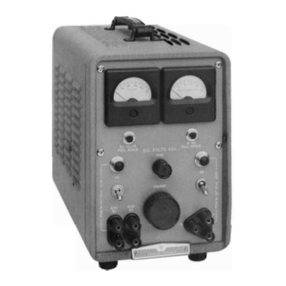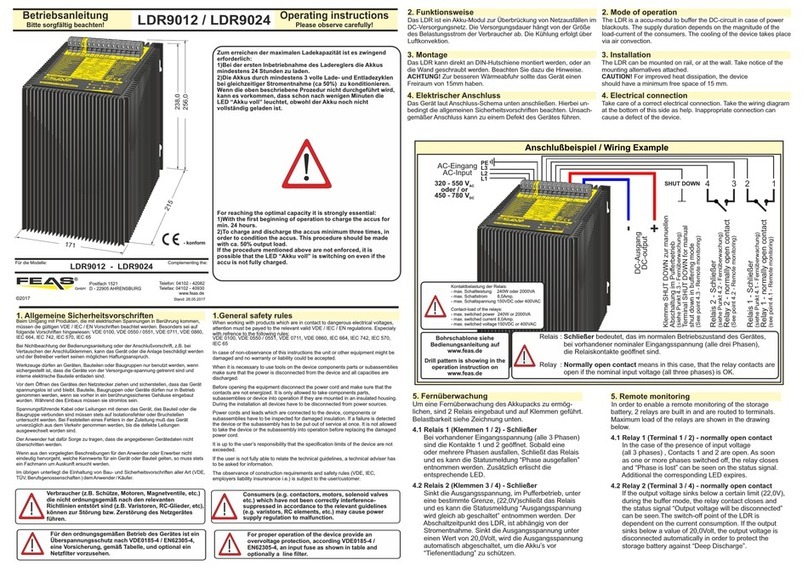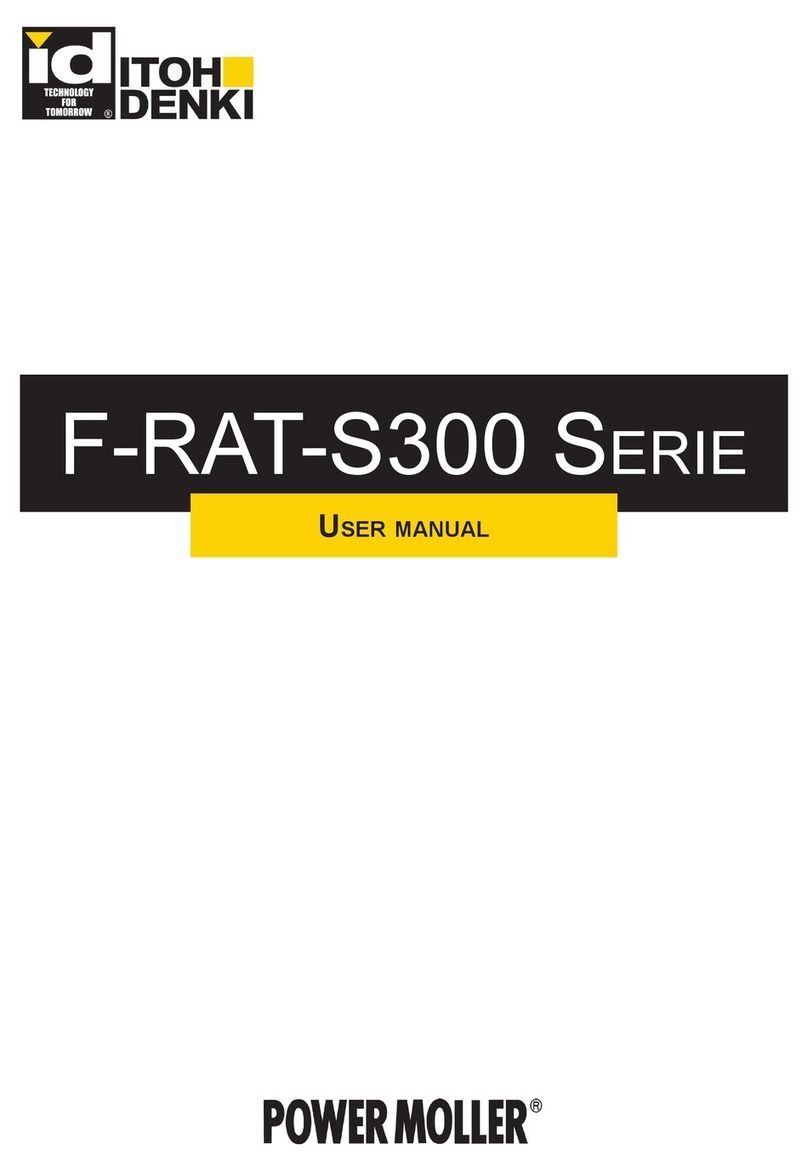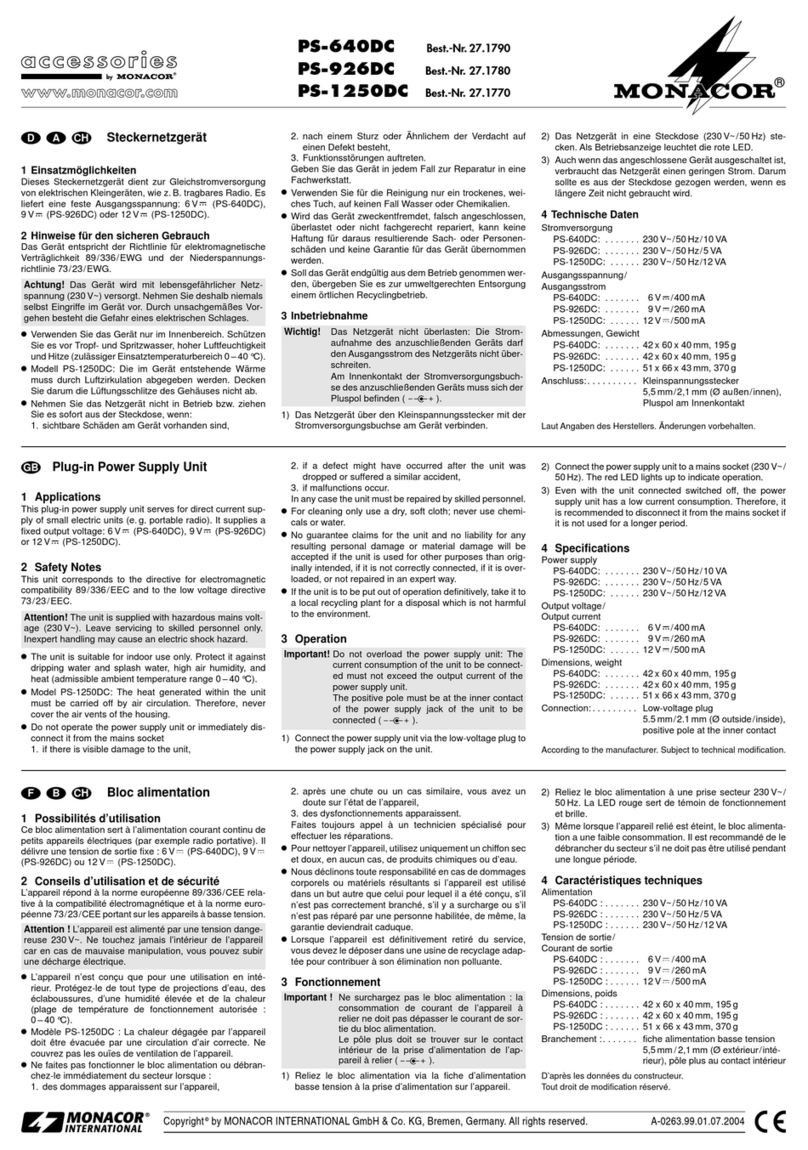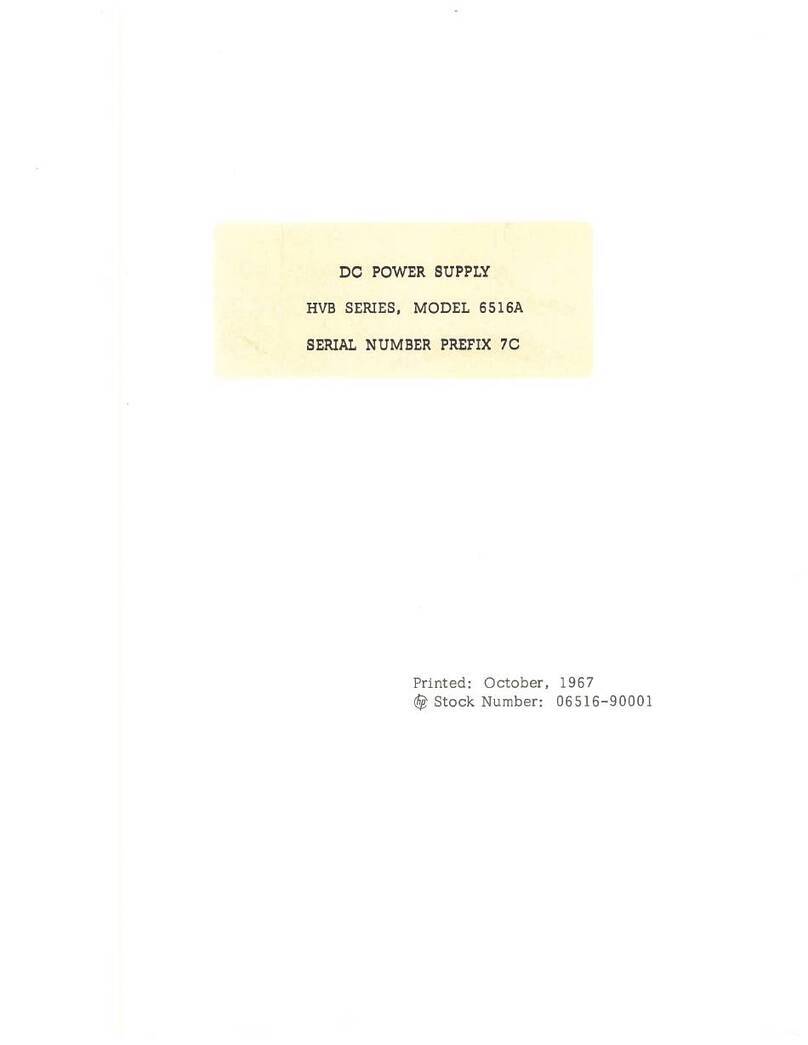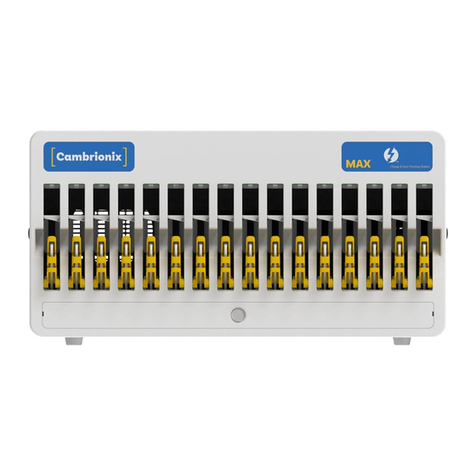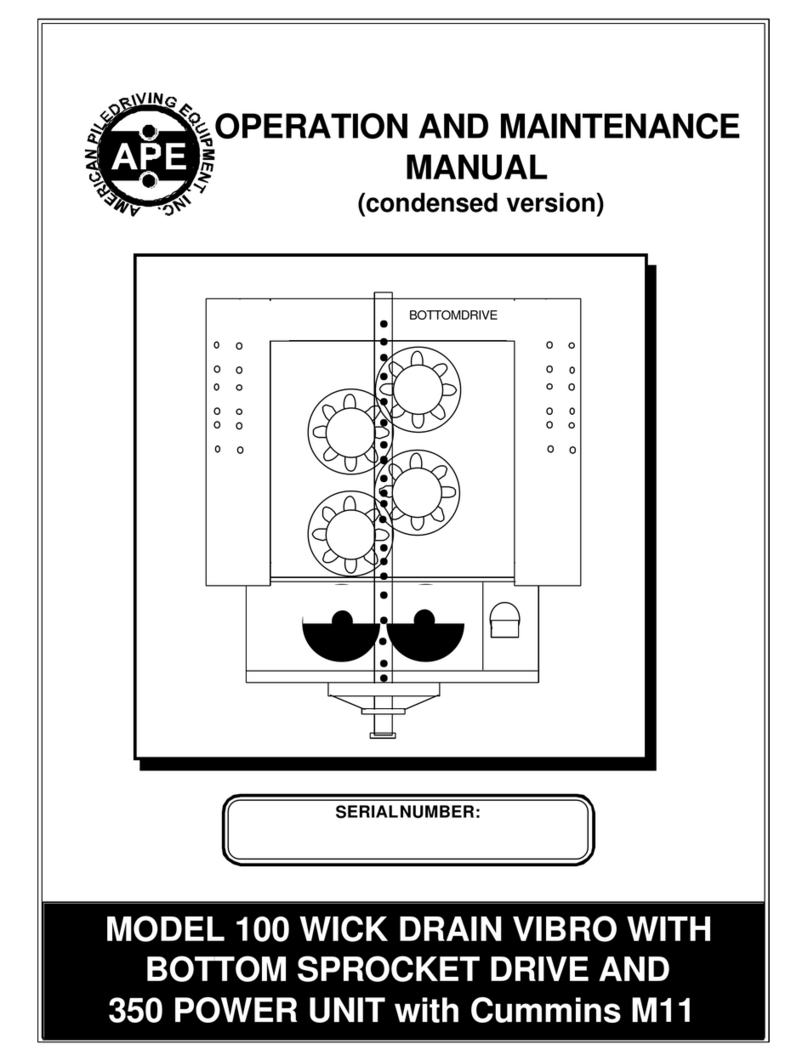Infinite Transtector DCIPS1B-S-00-B6 User manual

Installation Manual
© 2020 Innite Electronics, Inc. Transtector is a registered trademark of Innite Electronics, Inc. | DCIPS1B-M Rev. 1
DCIPS1B-S-00-B6 Power Supply System

Installation Manual | DCIPS1B-S-00-B6 Power Supply System
23
+1 (208) 635-6400 | www.transtector.com +1 (208) 635-6400 | www.transtector.com
Copyright © 2020 TRANSTECTOR
All Rights Reserved
Restricted Rights Legend:
Use, duplication, or disclosure by the Government is subject to restrictions as set forth in
subparagraph © (1)(ii) of the Rights in Technical Data and Computer Software clause at DFARS
252.227-7013 or subparagraphs © (1) and (2) of Commercial Computer Software - Restricted
Rights at 48 CFR 52.227-19, as applicable.
For Contact Information, please go to https://www.transtector.com/contact/
Refer to the TRANSTECTOR License Agreement in this package before installing or using this
product.
Unless specically noted, all addresses, data characters and persons referenced herein, and all
examples involving names of companies and products, are ctitious examples and are designed
solely to illustrate the use of TRANSTECTOR products.
Product names, logos, brands, and other trademarks featured or referred to within this product
manual are the property of their respective trademark holders. These trademark holders are not
aliated with TRANSTECTOR or our products. They do not sponsor or endorse our products.
LIMITATIONS AND AUTHORIZATIONS FOR USE AND PERMITTED APPLICATIONS
TRANSTECTOR’s products are not designed, intended for use in, or authorized for use as
critical components in, human life support systems/equipment, equipment used in hazardous
environments, or equipment used in nuclear control equipment or systems. Any such use requires
the prior express written consent of an authorized executive ocer of TRANSTECTOR, which
consent may be withheld by TRANSTECTOR in its sole discretion. Users assume all risk and
liability for, and agree to indemnify and defend TRANSTECTOR from and against any claims for
personal injury (including death) or property damage resulting from any such use or application
which is made in the absence of such prior express written consent.
If you nd errors or problems with this documentation, please notify TRANSTECTOR.
TRANSTECTOR does not guarantee that this document is error-free. The information in this
document is subject to change without notice.
Contents
Chapter 1 About This Manual
1.1 Objectives...............................................................................................................................6
1.2 Audience.................................................................................................................................6
1.3 Document Key........................................................................................................................6
1.4 Feedback & Support...............................................................................................................7
1.6 Disclaimer...............................................................................................................................7
Chapter 2 Aspiro System Description
2.1 Overview.................................................................................................................................8
2.2 System Congurations ...........................................................................................................8
2.3 System Parameters................................................................................................................9
2.4 System Components............................................................................................................11
2.4.1 System Controller......................................................................................................11
2.4.4 Rectier Module.........................................................................................................12
Chapter 3 System Safety
3.1 Safety Warnings and Guidelines ..........................................................................................13
3.1.1 System Markings.......................................................................................................13
3.1.2 Safety Recommendations .........................................................................................13
3.1.3 Installation Warning...................................................................................................14
3.1.4 Restricted Access Area Warnings .............................................................................14
3.1.5 Electrical and Fire Enclosure.....................................................................................14
3.1.6 System Enclosure......................................................................................................14
3.1.7 Operating Temperature Warnings..............................................................................14
3.1.8 Electrical Safety Warnings.........................................................................................14
3.1.9 Grounding..................................................................................................................15
3.1.10 Batteries ....................................................................................................................15
3.1.10.1 Lead Acid Batteries......................................................................................16
3.1.11 In Case of an Accident...............................................................................................16
3.2 Caution.................................................................................................................................16
3.2.1 Storage and Transportation.......................................................................................16
3.2.2 Disposal.....................................................................................................................17
3.2.3 Handling Electrostatic Sensitive Devices ..................................................................17
3.2.4 Traceability ................................................................................................................17
3.2.5 Breakers....................................................................................................................17
3.2.5.1 Circuit Breaker Limitations ............................................................................17
Chapter 4 Installation Guide
4.1 Introduction...........................................................................................................................18
4.2 Unpacking.............................................................................................................................18
4.3 Tools 18
4.4 Rack Mounting......................................................................................................................18
4.5 Rear Connections.................................................................................................................20
4.5.1 DC Earth Connection (FRAME GROUND)................................................................20
4.5.2 Mains Connection......................................................................................................21
4.5.3 Alarm and Signal Connections..................................................................................22
Revision History
REVISION DESCRIPTION CHECKED / APPROVED BY
& DATE
1 Initial Release DWR / 09-03-20

Installation Manual | DCIPS1B-S-00-B6 Power Supply System
45
+1 (208) 635-6400 | www.transtector.com +1 (208) 635-6400 | www.transtector.com
FIGURES
Figure 2-1 Power System Overview ...........................................................................................8
Figure 2-2 DCIPS1B-1200........................................................................................................12
Figure 4-1 Dimensional Drawing (Front and Top View)............................................................19
Figure 4-2 System Mounting (19” mount).................................................................................19
Figure 4-3 Rear Connections....................................................................................................20
Figure 4-4 DC Earth Connections.............................................................................................20
Figure 4-5 Mains Connection (viewed from rear) .....................................................................21
Figure 4-6 Mains Connection Detail .........................................................................................22
Figure 4-7 Signal Pin Designations ..........................................................................................23
Figure 4-8 Signal Connection Detail.........................................................................................24
Figure 4-9 Load and Battery Connections (Rear View)............................................................24
Figure 4-10 Signal Connection Detail.........................................................................................25
Figure 4-11 2-block Symmetry Measurement (for illustration only)............................................26
Figure 4-12 4-Block Symmetry Measurement (for illustration only)............................................26
Figure 4-13 Temperature Sensor Connection.............................................................................27
Figure 7-1 Unlocking the Controller..........................................................................................37
Figure 7-2 Removing the Controller..........................................................................................37
Figure 7-3 Replacing an DCIPS1B-1200 Rectier....................................................................38
Figure 7-4 Top Cover Removal.................................................................................................39
Figure 7-5 Breaker Removal - A................................................................................................40
Figure 7-6 Breaker Removal - B...............................................................................................40
TABLES
Table 4-1 Recommended Mains Circuit Protection.................................................................21
Table 4-2 Cable Sizes .............................................................................................................25
Table 4-3 Cable Sizes .............................................................................................................26
Table 5-1 Float/Boost Charge Voltages...................................................................................30
Table 5-2 Commissioning Record ...........................................................................................32
4.5.4 DC Load Connections ...............................................................................................24
4.5.5 Battery Connections .................................................................................................25
4.5.6 Symmetry Connection...............................................................................................26
4.5.7 Temperature Sensor Connection...............................................................................27
Chapter 5 Commissioning
5.1 Commissioning Overview.....................................................................................................28
5.2 Tools and Test Equipment.....................................................................................................28
5.2.1 Tools List....................................................................................................................28
5.2.2 Test Equipment..........................................................................................................28
5.3 Preparation...........................................................................................................................28
5.4 Commissioning procedure....................................................................................................29
5.5 Test of output voltage ...........................................................................................................30
5.5.1 Float charge (U1).......................................................................................................30
5.5.2 Adjustment of Float Charge, U1................................................................................30
5.5.3 Boost charging (U2) (if applicable)............................................................................30
5.6 Battery supervision...............................................................................................................31
5.7 Battery test ...........................................................................................................................31
5.8 Commissioning record..........................................................................................................32
Chapter 6 Maintenance & Troubleshooting
6.1 Maintenance.........................................................................................................................33
6.2 Troubleshooting....................................................................................................................33
Chapter 7 Replacing Modules
7.1 Controller Replacement........................................................................................................37
7.2 Rectier Replacement ..........................................................................................................38
7.2.1 DCIPS1-1200 Replacement......................................................................................38
7.3 Breaker Replacement...........................................................................................................39
Appendix A - Block Diagram......................................................................................................41
Appendix B - CSA Certicate Extract.........................................................................................42

Installation Manual | DCIPS1B-S-00-B6 Power Supply System
67
+1 (208) 635-6400 | www.transtector.com +1 (208) 635-6400 | www.transtector.com
1. About This Manual
This chapter contains an overview of the information that is presented in this Power
System Manual. This includes information on objectives, the intended audience, and the
organization of this manual. In addition, this chapter also denes the conventions used to
indicate warnings, cautions and noteworthy information.
1.1 Objectives
This manual describes the Power System, explains how to unpack and install the system,
how to perform the initial power-up and operational system check.
The information presented in this document is current as of the publication date.
1.2 Audience
This manual is to be used by installers and technicians who are preparing the site for a
new installation and installing the power system. This manual assumes that the technician
has an understanding of power systems in general and understands safety procedures for
working around AC and DC voltage.
The user of this document should be familiar with electronic circuitry and wiring practices
and have some expertise as an electronic, power, or electromechanical technician.
1.3 Document Key
This manual uses the following conventions:
WARNING This symbol indicates a situation that could cause bodily injury.Always
be aware of hazardous conditions when working in or around the power system.
CAUTION Thissymbol indicates asituation that mightresult inequipment damage.
The reader should be aware that their actions could result in equipment or data
loss.
NEED MORE INFORMATION? This symbol is used to reference information
either in this manual or in another document.
NOTE This symbol means the reader should take note. Notes are helpful
suggestions or reminders.
Chapter 1 About This Manual
Table 1-1 Abbreviations
Abbreviation Description
PCC Prime Controller Card
ACX Advance Controller Card
LVD Low Voltage Disconnection
PLD Partial Load Disconnection
DCIPS1B-1200 1200 W Rectier
DB22 Distribution Drawer (4 x load, 1 x battery)
1.4 Feedback & Support
Phone: +1-208-635-6400
Web site: www.transtector.com
When contacting TRANSTECTOR, please be prepared to provide:
1. The product model number, spec number, S build number, and serial number - see the
equipment nameplate on the front panel
2. Your company’s name and address
3. Your name and title
4. The reason for the contact
5. If there is a problem with product operation:
• Is the problem intermittent or continuous?
• What revision is the rmware?
• What actions were being performed prior to the appearance of the problem?
• What actions have been taken since the problem occurred?
1.5 Layout, Numbering and Printing
This manual is intended for two-sided black and white printing. Some pages are intentionally
left blank.
1.6 Disclaimer
TRANSTECTOR is not responsible for system problems that are the result of installation or
modication of the instructions provided in this manual.

Installation Manual | DCIPS1B-S-00-B6 Power Supply System
89
+1 (208) 635-6400 | www.transtector.com +1 (208) 635-6400 | www.transtector.com
2.1 Overview
DCIPS1B DC power systems oer a range of solutions for diverse applications such as
broadband access, cable head ends, micro/pico BTS Cells, Enterprise, E911, and GSM-R.
The DCIPS1B shelf system utilizes ecient, dense, and reliable plug-in rectier modules
DCIPS1B-1200, with output power available at 1200W per rectier, based upon a
soft-switching approach. Features include wide input operating range, wide operating
temperature, full self-protection and three LEDs for immediate rectier status indication.
The power system can be managed locally through messages and alarm displayed on the
LCD screen of the system controller or remotely, using the PC-based PowCom™ software,
or through a web browser with Ethernet connection.
2.2 System Congurations
DCIPS1B 1U system consists of:
1. System Controller ACX Advanced
2. 4 x Load and 1 x Battery breakers including LVD
3. DCIPS1B-1200 Rectiers (Maximum 2)
4. Rear Connections
1
2
3
4
Figure 2-1 Power System Overview
Chapter 2 Aspiro System Description
2.3 System Parameters
OUTPUT
Power (max) 2400W @ >180VAC, 800W @ <180VAC
Output Current 52A max. @ 46VDC, 45A nominal (see appendix B)
15A (Low Power Shelf version with 20A shunt)
Voltage 46-57VDC
INPUT
Voltage 85-275VAC (Single-phase, 2 x Single-phase)
Frequency 50-60Hz
Input Current 16A (Single-phase), 8A (2 x Single-phase)
Power factor >0.98
DC DISTRIBUTION
Battery Breakers 1 x (AIRPAX, IER Series)
Ratings 40A, 50A, 65A
Load Breakers 4 x (NADER NDB3 Series)
Ratings* 1A, 4A, 5A, 7.5A, 10A, 15A, 20A, 25A, 30A
MONITORING AND CONTROL
Controller PCC or ACX Advanced
Local Interface 4 x 20’ LCD, 4-key menu, USB (ACX only) and RS232
Remote Interface Ethernet / Modem using PowCom™ software
Visual Indication Green LED - System On
Yellow LED - Message(s)
Red LED - Alarm(s)
Analog Inputs 12 x voltage inputs (range 0-100VDC) - used for symmetry inputs
Analog Outputs 4 x potential free relays (C, NC, NO)
Digital Inputs 2 x, Logic 0: U<10VDC, Logic 1: U>12VDC
Digital Outputs 2 x, open collector type
Temperature measurement 2 x Temperature probe (Battery, Ambient)
CONNECTIONS
Battery connections Stripped cable, max.16mm2, spring type connector
AC connections Stripped cable with ferule, max. 2.5mm2, screw type connector
Load breaker connections Stripped cable with ferule, max. 4mm2, screw type connector
Alarm connections Stripped cable with ferule, max. 1.5mm2, screw type connector
* For load breaker derating limitations see chapter 3.2.5 Breakers on page 3-6.

Installation Manual | DCIPS1B-S-00-B6 Power Supply System
10 11
+1 (208) 635-6400 | www.transtector.com +1 (208) 635-6400 | www.transtector.com
RECTIFIER MODEL DCIPS1B-1200
Eciency 95% typical @ Iout nom
Input Current (max) <7.3A
Output Current (max)
53.5V oat
22.4A
Output Power 1200W @ >180VAC
750W @ 90-180VAC
Operating Temperature
(without derating) 55°C
Input Voltage
(Nominal 100-240VAC) 90-300VAC
Output Voltage 46-57VDC
Load sharing < 5% of nominal current
Dimensions (WxHxD) 40.6 (1.6”) x 101.62(4”) x 228.5(9”) mm
Weight 1.1 kg
Cooling Fan-cooled, speed and alarm controlled, air ow direction rear to front
Protection Short circuit proof, automatic current limiting, selective shutdown of modules at
excessive output voltage.
Alarms High output voltage/ shutdown, Low voltage/ module failure
LED Indication Green: Power ON
Yellow: Current limit/ thermal protection
Fan failure / Over temperature
Pre-warning / thermal protection
Communication Failure (ashing)
Red: Module failure / high output voltage shutdown
Audible noise <55dBA according to ISO7779
MECHANICAL
Dimensions (WxHxD) 480 mm x 44.45 mm x 266 mm
Weight of the system
(fully equipped) 6.5 kg
Mounting Options 19”/ ETSI / Mid-mount
Cable Entry Rear Access
STANDARD COMPLIANCE / ENVIRONMENTAL
EMC and Immunity ETSI EN 300 386 V.1.5
EN 55022
EN 55024, EN 61000-4
Safety EN 60950-1
Operating Temperature -40°C to +75°C, derating over +47°C (see appendix B)
Storage Temperature -40°C to +85°C
2.4 System Components
The DCIPS1B system is delivered with all components mounted according to the ordered
conguration. The main components are described below and in later chapters of the
manual.
There are 2 versions of DCIPS1B shelf available depending on the value of battery current
shunt used: 20 A or 80 A.
CAUTION Low Power Shelf version (20 A version) provides better resolution for battery
current reading and it is suitable for low power applications with maximum battery charge
current less than 5A.
2.4.1 System Controller
The DCIPS1B power system can be controlled by the ACX Advanced controller. The
description and operation of this controller is covered in a separate manual which
isavailable at: www.transtector.com
2.4.2 DC Distribution
DC Distribution consists of maximum 1 battery and 4 load breakers available in a variety
of sizes.
The distribution unit is designed for switching the battery and load on and o.
The battery and load breakers are supervised by measuring the voltage drop across
each breaker. In the case of load breakers, those which are not connected to any load
will not cause a breaker alarm even if they are left open.
A battery fuse alarm is generated after the battery voltage drops below a certain level,
depending on the actual battery capacity and condition.
Low Voltage Disconnect (LVD)
The system is equipped with a low voltage battery disconnect which prevents the
batteriesfrom deepdischarging,thusprolongingthe batterylife. Thedisconnectrequires
a detected mains failure at the supervision unit (controller).
If disconnection occurs, the batteries will not supply power to the load until they have
been recharged to a set voltage level, which can be adjusted by the user.
If disconnection occurs, the batteries will be reconnected when the mains supply returns.

Installation Manual | DCIPS1B-S-00-B6 Power Supply System
12 13
+1 (208) 635-6400 | www.transtector.com +1 (208) 635-6400 | www.transtector.com
2.4.4 Rectier Module
The Fan-Cooled DCIPS1B-1200 1200W rectiers are modular power supplies designed
for parallel operation and hot-plug installation in the DCIPS1B Power Systems.
Each rectier provides extremely reliable DC power in a very high density. The module
incorporates power monitoring through an internal microprocessor, giving up to the
second updates to the system controller and companion rectiers. This guarantees
tightly controlled load sharing among rectiers, and provides status and identication
information to the controller.
The rectiers operate in parallel using active load sharing. They incorporate soft-start
at both the input and the output, which protects against high incoming and outgoing
currents. The output voltage of the rectier is automatically adjusted to the required
voltage by the controller.
Figure 2-2 DCIPS1B-1200
Chapter 3 System Safety
3.1 Safety Warnings and Guidelines
Thefollowing warnings andguidelines shouldbefollowed by properlytrained andauthorized
personnel when installing, operating, commissioning or maintaining this equipment.
Neglecting the instructions may be dangerous to personnel and equipment.
3.1.1 System Markings
The following markings are found on the Power System:
Ground Symbol
DC Ground Symbol
Product Label - The product label contains the system part number, model number, system
ratings and safety approvals. The label is located on the left side of top cover.
3.1.2 Safety Recommendations
Any device that uses electricity requires proper guidelines to ensure safety.
• The Power System should only be installed or serviced by a qualied personnel.
• Always keep tools away from walkways and aisles. Tools present a tripping hazard
in conned areas.
• Keep the system area clear and dust-free during and after the installation.
• Always know the location of emergency shut-o switches in case of an accident.
• Always wear appropriate eye protection and use appropriate tools for working with
high voltage equipment.
• Do not perform any action that creates a potential hazard to other people in the
system area.
• Never work alone in potentially hazardous conditions.
• Always check for possible hazards before beginning work.
• Remove watches, rings and jewelry that may present a hazard while working on the
power system.

Installation Manual | DCIPS1B-S-00-B6 Power Supply System
14 15
+1 (208) 635-6400 | www.transtector.com +1 (208) 635-6400 | www.transtector.com
3.1.3 Installation Warning
Thefollowing safety guidelinesshould beobservedwhen transporting ormoving thesystem:
• Before moving the Power System, read the system specications sheet to determine
whether the install site meets all the size, environmental, and power requirements.
• The system and the equipment included, should only be moved and installed by
qualied personnel to prevent bodily injury or any other hazardous conditions.
3.1.4 Restricted Access Area Warnings
The Power System is designed for installation in locations with restricted access often
secured by a locking mechanism. It can therefore be accessed only by a trained service
person, who is fully aware of the restrictions applied to the location, or by an authority
responsible for the location.
3.1.5 Electrical and Fire Enclosure
The unit is for building-in. Asuitable Electrical and Fire enclosure shall be provided.
3.1.6 System Enclosure
Appropriate measures need to be taken to avoid intrusion of any unwanted objects or insects
into conductive areas of the power system as there is a potential risk of system damage.
Disclaimer: TRANSTECTOR assumes no liability or responsibility for system failures
resulting from inappropriate enclosure around the system.
3.1.7 Operating Temperature Warnings
To prevent the Power System from overheating, an automatic shutdown mechanism has
been installed. It is not recommended to continually operate the Power System in an area
that exceeds the maximum recommended operating temperature.
3.1.8 Electrical Safety Warnings
The following are electrical safety recommendations for working near the Power System:
WARNING Observe low voltage safety precautions before attempting to work on the
systemwhen power isconnected.Potentially lethal voltagesare presentwithinthe system.
WARNING Caution must be exercised when handling system power cables. Damage to
the insulation or contact points of cables can cause contact with lethal voltages. For safety
reasons, cables should be connected to the power system before power is applied.
• Remove all metallic jewelry like watches or rings that may present a hazard while
working on the power system.
• Before connecting the AC input source to the power system, always verify voltage.
• Verify the AC source capacity. See system specications for AC information.
• All AC connections must conform to local codes and regulations, e.g. ANSI, CEC,
NEC, etc.
• When makingAC connections, allAC power and DC load distribution breakers should
be in the OFF position.
• All circuit breakers should meet the original design specications of the system. In
addition, equipment connected to the system should not overload the circuit breakers
as this may have a negative eect on overcurrent protection and supply wiring,
causing system or user harm.
• Verify the DC capacity before making connections. See system specications for DC
information.
• Potentiallylethalvoltagesarepresentwithinthesystem. Ensurethatallpowersupplies
are completely isolated by turning all power switches OFF, disconnecting all relevant
connectors and removing all relevant breakers before attempting any maintenance
work. Do not rely on switches alone to isolate the power supply. Batteries should
also be disconnected.
• Potentially lethal voltages are present within this system. Ensure that low voltage
safety requirements are implemented before attempting to work on the system with
power connected.
• Potentially lethal voltages can be induced if the equipment is not grounded (earthed)
correctly. Ensure that all ground connections are secure.
3.1.9 Grounding
WARNING Grounding connection must be performed before operating the system. Refer
to local codes, e.g.ANSI, CEC, NEC, T1-333, ETSI 300-386-TC specifying the connection
of power system to building ground. In case of any doubt regarding the grounding
connection, please contact a person responsible for the system.
WARNING The system should be hard-wired to the incoming earth ground. A solid high
current ground connection capable of sinking the maximum system current is required.
3.1.10 Batteries
WARNING When installing or replacing batteries, there is risk of explosion if an incorrect
battery type is used.

Installation Manual | DCIPS1B-S-00-B6 Power Supply System
16 17
+1 (208) 635-6400 | www.transtector.com +1 (208) 635-6400 | www.transtector.com
3.1.10.1 Lead Acid Batteries
WARNING This equipment may use Lead Acid Batteries. When handling batteries,
follow the instructions included with the battery set, as the uids contained within these
batteries are known to be a health hazard. The disposal of lead acid batteries is subject
to legal requirements for hazardous waste disposal. Local guidelines should be followed
for disposal.
Ensure the following guidelines are observed when dealing with equipment that may contain
lead acid batteries:
• Any attempt to burn these batteries may result in an explosion and the generation of
toxic fumes.
• Should a lead acid battery suer damage, it must be moved into a well-ventilated
area. Contact with the corrosive uid must be avoided.
• Neutralize any acid corrosion with copious amounts of a solution of baking soda and
water, and then wipe o all traces of soda.
• If the lead acid battery is removed from the equipment, any exposed contact must be
insulated prior to disposal.
• Ensure that protective full-face shields, rubber gloves and aprons are worn and
insulated tools are used when working with the batteries. It is advised also to have
water available in case acid gets in contact with the eyes.
3.1.11 In Case of an Accident
In the event of an accident resulting in injury:
1. Use caution and check for hazards in the area.
2. Disconnect power to the system.
3. If possible, send someone to get medical aid. If not, check the condition of the victim
and call for help.
3.2 Caution
3.2.1 Storage and Transportation
CAUTION During storage and transportation, the units must remain in their original
packages in order to avoid mechanical damage, maintain tracability, and protect the units
against electrostatic discharge.
3.2.2 Disposal
CAUTION The product should not be disposed with other wastes at the end of its working
life so as to prevent possible harm to the environment or human health from uncontrolled
waste disposal.
3.2.3 Handling Electrostatic Sensitive Devices
CAUTION An electrostatic sensitive device is an electronic component that may be
permanently damaged by the discharge of electrostatic charges encountered in routine
handling, testing and transportation.
3.2.4 Traceability
CAUTION Units are labeled with permanently attached product identication labels.
The labels are designed to be indelible throughout the life span of the equipment, unless
mistreated. Make sure that the product identication labels are present on the equipment
and are not subjected to unusual wear or mistreatment.
3.2.5 Breakers
CAUTION Breakers should always be replaced with the same type and rating in order to
avoid damage to system components.
3.2.5.1 Circuit Breaker Limitations
1. Limitations for ambient temperature up to 47°C, maximum system output current 45
Amps:
Maximum load per circuit breakers rated:1A, 4A, 5A, 7.5A, 10A, 15A, 20A and 25A is
80% of their nominal rate.
Maximum load per circuit breaker rated 30A is 60% of its nominal rate.
2. Limitations for ambient temperature up to 55°C, maximum system output current 45
Amps:
Maximum load per circuit breakers rated:1 A, 4 A, 5 A, 7.5 A, 10 A, 15 A, 20 A and 25 A
is 80% of their nominal rate.
Maximum load per circuit breaker rated 30 Ais 60% of its nominal rate.
3. Limitations for ambient temperature up to 75°C, maximum system output current 28
Amps:
Maximum load per circuit breakers rated:1 A, 4 A, 5 A, 7.5 A, 10 A, 15 A, 20 A and 25 A
is 30% of their nominal rate.
Maximum load per circuit breaker rated 30 Ais 20% of its nominal rate.

Installation Manual | DCIPS1B-S-00-B6 Power Supply System
18 19
+1 (208) 635-6400 | www.transtector.com +1 (208) 635-6400 | www.transtector.com
Chapter 4 Installation Guide
WARNING There are potential hazards related to installing this power system. It
is important to carefully read and understand the contents of Chapter 3 System
Safety before performing system installation.
CAUTION Make sure sucient room is left around the system, enabling optimal air
circulation and thus preventing the system from overheating. Keep vent openings
from blocking.
4.1 Introduction
This chapter provides detailed instructions for installing the DCIPS1B 1U Power System.
4.2 Unpacking
Check that the received equipment is in accordance with the packing list. Ensure that the
cabinet and the equipment have not been damaged during transportation.
Report any parts that are damaged, missing or incorrect. If possible, correct the problem
before continuing.
4.3 Tools
The following tools are required for a safe installation of the system:
WARNING Use only single-ended, fully insulated tools. Shafts of for example
screwdrivers should be insulated.
• Anti-static hand strap.
• Insulated screwdrivers, at, sizes 1, 2 and 3.
• Insulated screwdrivers, pozidrive (cross-slot), sizes 1, 2 and 3.
• Insulated torque spanner (for battery connection).
4.4 Rack Mounting
The power system is designed for rack mounting, and the default bracket is for 19 inch rack
width. This bracket can be easily adjusted to 23” or ETSI mounting. See Figure 4-1 below.
The brackets are front mounted but can be moved by the user for center mount rack setup.
There needs to be sucient clearance at the front for rectier installation, and at the rear
for connections. When using side mains and DC connectors, sucient space should be
allowed for access in this case.
0.22 (5.6)
0.98 (25.0)
1.26 (32.0)
0.98 (25.0)
10.49 (266.45)
16.81 (426.9)
22.21 (564.2) [23”]
22.90 (581.7) [23”]
18.90 (480.1) [19”]
18.21 (462.6) [19”] 1.25 (31.75)
1.72
(43.6)
0.27 (6.8)
7.19 (182.5)
0.55 (14.05)
0.98 (25.0)
0.59 (15.0)
0.98 (25.0)
7.52 (190.95)
10.30 (261.0)
10.63 (270.0)
19” 23”
Figure 4-1 Dimensional Drawing (Front and Top View)
The DCIPS1B system can be easily mounted to a rack using the taptite screws to fasten the
mounting brackets to the rack as shown in Figure 4-2.
NOTE It is recommended to remove the rectiers before installing the shelf to the cabinet
or rack.
Figure 4-2 System Mounting (19” mount)

Installation Manual | DCIPS1B-S-00-B6 Power Supply System
20 21
+1 (208) 635-6400 | www.transtector.com +1 (208) 635-6400 | www.transtector.com
4.5 Rear Connections
All cable connections for the DCIPS1B system are available at the rear of the system, see
Figure 4-3.
CAUTION Use UL-listed wires with an insulation rating to at least 90°C.
WARNING Before inserting the cable into the connector, remove as little insulation on the
cable as possible, to prevent the stranded conductor to come loose and touch any other
conductive parts.
SIGNAL
CONNECTIONS
BATTERY
CONNECTIONS
AC
CONNECTIONS
RS485
LOAD
CONNECTIONS
FRAME
GROUND
1-phase 2 x 1-phase
X9 X10 X6 X5
GMT CONFIGURATION
Figure 4-3 Rear Connections
4.5.1 DC Earth Connection (FRAME GROUND)
WARNING The power system needs to be properly grounded to the rack or cabinet frame
to ensure its safe and ecient operation.
The Earth Connection (Frame Ground) of the rack is located on the rear as shown in Figure
4-3.
To connect:
1. Loosen the screw (M5).
2. Attach suitably sized cable lug.
3. Tighten the screw with torque 3.5Nm.
Recommended cable size is 6 mm2.
Figure 4-4 DC Earth Connections
4.5.2 Mains Connection
WARNING Ensure that mains input is turned o before connecting. The grounding
must be connected to PE terminal as rst.
CAUTION Depending on deployment region with regards to lightning strikes and
heavy inductive energy, it is highly recommended to install AC Surge Protection
Class C.
The DCIPS1B system family is available with two options for mains connection:
• Single-phase / Phase to Phase (USA) connection
• 2x Single-phase / Phase to Phase (USA) connection
First, check which mains solution is delivered and then follow the appropriate installation
instructions below.
Connectors are situated on the right rear side of the system (Figure 4-3), labeled and
congured as seen in Figure 4-5.
SIGNAL
CONNECTIONS
BATTERY
CONNECTIONS
AC
CONNECTIONS
RS485
LOAD
CONNECTIONS
FRAME
GROUND 1-phase 2 x 1-phase
X9 X10 X6 X5
GMT CONFIGURATION
Figure 4-5 Mains Connection (viewed from rear)
Shelf Type
(See product label) Number of
Rectiers
Imax at
100 VAC Recommended
Mains CB
Single-phase
AC Input 218.6 A
at 100VAC C32A
2 x Single-phase
AC Input 29.3 A
at 100VAC 2 x C32A
Table 4-1 Recommended Mains Circuit Protection

Installation Manual | DCIPS1B-S-00-B6 Power Supply System
22 23
+1 (208) 635-6400 | www.transtector.com +1 (208) 635-6400 | www.transtector.com
To connect:
1. Remove sucient insulation from the
cables and insert stripped cables into the
appropriate terminal.
2. Tighten the corresponding terminal
screw with a at screwdriver, see Figure
4-6.
Maximum cable size is 2.5mm2.
Maximum torque required for tightening
the screw is 0.5Nm.
Figure 4-6 Mains Connection Detail
4.5.3 Alarm and Signal Connections
Alarm and Signal connections are positioned on the left rear side of the Power Shelf, see
Figure 4-3.
For remote supervision of alarms, there are 4 potential free alarm contacts available. Each
alarm contact represents dierent condition. Multi Purpose Voltage Inputs 1-12 can be
recongured as external analog inputs.
The pin description detail for all signal connections is shown in Figure 4-7.
Alarm connections are Form C relays and can be monitored either Normally Closed (NC) or
Normally Opened (NO). When the power is OFF NC is closed and when the power is ON
NC is open.
NOTE Each alarm contact represents a dierent alarm condition or conditions.
These is dened in the controller’s alarm matrix setup.
77
88
99
44
55
66
11
22
33
X9 X10
Multipurpose 10
Multipurpose 11
Multipurpose 12
10 11 12 13 14 15 16 17 18 10 11 12 13 14 15 16 17 18
0V
Sense
+5V
0V
Sense
+5V
Battery
Temp. Ambient
Temp.
Alarm 4 - C
Alarm 4 - NC
Alarm 4 - NO
Alarm 1 - C
Alarm 1 - NC
Alarm 1 - NO
Alarm 2 - C
Alarm 2 - NC
Alarm 2 - NO
Alarm 3 - C
Alarm 3 - NC
Alarm 3 - NO
Multipurpose 1
Multipurpose 2
Multipurpose 3
Multipurpose 4
Multipurpose 5
Multipurpose 6
Multipurpose 7
Multipurpose 8
Multipurpose 9
Digital In 1
Digital In 2
Digital Out 1
Digital Out 2
-
V Sys.
+V Sys.
Alarm Condition Shown
C
NC
NO
Figure 4-7 Signal Pin Designations

Installation Manual | DCIPS1B-S-00-B6 Power Supply System
24 25
+1 (208) 635-6400 | www.transtector.com +1 (208) 635-6400 | www.transtector.com
To connect:
1. Release a connector from the terminal
using a screwdriver and pull it out.
2. Remove sucient insulation from the
cables and insert stripped cables into
the appropriate connector. Then tighten
the corresponding terminal screw using
a at screwdriver Figure 4-8.
3. After fastening all the cables, insert the
connector back into the terminal block.
Maximum cable size is 1.5mm2.
Maximum torque required for tightening
the screw is 0.25Nm.
Figure 4-8 Signal Connection Detail
4.5.4 DC Load Connections
Load Connections are available at the rear, with connections labeled corresponding to each
load breaker, Figure 4-9.
F1- F1+ F2- F2+ F3- F3+ F4- F4+
Batt - Batt +
Figure 4-9 Load and Battery Connections (Rear View)
For DC load connections follow instructions given in Figure 4-6.
Maximumcable size is4.0mm2. Maximum torquerequired fortightening thescrewis 0.6Nm.
CAUTION For correct electrical polarity of DC loads see connector labels.
Load
Breaker Size
[A] 1A 4A 5A 7.5A 10A 15A 20A 25A 30A
Wire Size
[mm2/AWG] 1/18 1/18 1/18 1/18 1/18 2.5/14 2.5/14 4/12 4/12
Table 4-2 Cable Sizes
4.5.5 Battery Connections
WARNING Improper handling with batteries can be dangerous. Please read and
understand the information in the Safety chapter before connecting batteries.
CAUTION Follow closely the battery manufacturer’s specications regarding the
maximum battery charge current value. If the value is less than 5 A, Low Power
Shelf version is required.
WARNING The battery cables should be connected to the shelf as rst, then to the
batteries. If the battery cables are already connected to the batteries disconnect
the -48 V cable from the battery at least.
Battery connections are available at the rear of the system adjacent to the load connections,
see Figure 4-6.
To connect:
1. Remove sucient insulation from the
cable (max. 12mm). Make sure no single
stranded wire comes loose and touch
any other conductive wire.
2. Insert a at screwdriver into the square
opening of the battery connection to
release a spring latch.
3. Insert the stripped cable into the
appropriate round opening.
4. Connect the other end of the battery
cables to the batteries.
Figure 4-10 Signal Connection Detail

Installation Manual | DCIPS1B-S-00-B6 Power Supply System
26 27
+1 (208) 635-6400 | www.transtector.com +1 (208) 635-6400 | www.transtector.com
Battery
Breaker Size
[A] 40A 50A 65A
Wire Size
[mm2/AWG] 10/6 10/6 16/4
Table 4-3 Cable Sizes
4.5.6 Symmetry Connection
1. Attach the interblock connection plates between the batteries.
2. Insert a suitably sized cable lug into one pole of the interblock connection plate. Fasten
the lugs and plates to individual battery poles.
3. For 2-block battery symmetry measurement x one wire of the symmetry cable to the
cable lug in the mid-point of the battery string, see Figure 4-11.
4. For 4-block measurement x the 3 wires (red, green and blue) of the symmetry cable
to individual cable lugs. Colour coding of the cables must be respected for proper
symmetry measurement see Figure 4-12.
Figure 4-11 2-block Symmetry Measurement (for illustration only)
Figure 4-12 4-Block Symmetry Measurement (for illustration only)
NOTE The interblock Connection Kit is not delivered with the system.
NOTE Symmetry cable is normally pre-connected to the system, see Figure 4-7.
4.5.7 Temperature Sensor Connection
Temperature Sensor Connection for supervising battery temperature is usually delivered
pre-installed when used. On the occasion that it is tted later it is connected using the three-
pin plug according to the same procedure as for the alarm connections.
The sensor itself should be fastened to the battery after battery installation: Unwind the
cable, remove the paper covering the adhesive for the sensor and fasten the sensor to the
battery as shown in Figure 4-13.
Temp. Sensor
Figure 4-13 Temperature Sensor Connection
NOTE Temperature sensor is normally pre connected to the system, see Figure
4-7.

Installation Manual | DCIPS1B-S-00-B6 Power Supply System
28 29
+1 (208) 635-6400 | www.transtector.com +1 (208) 635-6400 | www.transtector.com
Chapter 5 Commissioning
5.1 Commissioning Overview
Before delivery the system was thoroughly inspected and tested. The following chapter is a
guide to the set-up and operation of the control functions of the system.
NOTE Before starting commissioning read the product description for the individual
components.
WARNING ONLY TECHNICAL STAFF WITH THE NECESSARY EXPERIENCE AND
KNOWLEDGE, WITH REGARD TO THE POWER SUPPLY SUPPORTSYSTEMAND ITS
BATTERIES, MAY PERFORM THE COMMISSIONING. IT IS IMPORTANT TO FOLLOW
ALL SAFETY REGULATIONS.
If there are any diculties in increasing the voltage to alarm level, the alarm level can be
adjusted to a lower level.
5.2 Tools and Test Equipment
5.2.1 Tools List
The essential commissioning tools are listed in the Installation chapter.
5.2.2 Test Equipment
• Multimeter (3½ Digit, 0–1%DC)
• Load resistance, to fully load of two rectiers
5.3 Preparation
Check the installation to ensure the following:
• Grounding: The equipment is correctly grounded. The grounding cable size, color and
routing conform to the requirements.
• Power: The incoming mains AC power is available for this site. The site power switch
and circuit breakers are clearly labeled. The power cables are correctly terminated.
• The site is clean and safe. Check that the system/cabinet is free of any unwanted
objects or insects that may have got in during the installation.
5.4 Commissioning procedure
1. Remove the covers and check that all connections are made according to the installation
drawing. Verify that all connections are properly tightened with sucient torque.
2. Ensure that load and battery MCB breakers are set to OFF position - ensuring the load
and battery strings are connected.
3. Ensure that all rectier modules are removed. If not, remove each one in turn starting
from the rightmost position.
4. If the rectier subrack has dip switches for addressing, verify that the dip switches are
set correctly.
5. Check the battery polarity with the multimeter (3½ Digit, 0·1% dc). Place the positive
lead of the meter to the positive busbar and the negative lead to the battery breaker.
The meter must now show a positive voltage. If the voltage is negative, change over the
connection of the blue and black battery cables to the batteries.
6. Turn on the AC mains voltage.
7. Measure the AC voltage on the AC terminal block between phases and neutral. The
correct value is approximately 120V/230V. If the value is dierent, check the AC
connection.
8. Plug in all rectier modules, starting from the leftmost position. Make sure to fasten the
rectiers again. The rectiers will turn on automatically.
9. Set all load breakers into the “1” (ON) position.
10. Verify correct polarity on the battery connection by measuring the voltage drop across
the battery breaker(s) (Normally not more than 5V DC).
11. The green LED on the controller should blink for approximately 20 sec.
12. The output voltage will increase slowly to U1 (oat charge voltage).
13. Turn the battery breaker(s) to the “1” (ON) position.
14. If any alarms are present, they should be reset in accordance with the procedure for the
installed controller, ACX or PCC.
15. The system should now be without alarms.
16. Attach all the system covers in their correct places.
17. Check that all changes to drawings, if any, have been completed.
18. Clean the site.
19. Fill in the commissioning record (see end of chapter).

Installation Manual | DCIPS1B-S-00-B6 Power Supply System
30 31
+1 (208) 635-6400 | www.transtector.com +1 (208) 635-6400 | www.transtector.com
5.5 Test of output voltage
5.5.1 Float charge (U1)
Ensure that the controller is operating.
Connect a load, approx. 50% of total capacity, to the system.
Check the voltage according to the battery manufacturer’s requirements. If the batteries
require a dierent oat charging voltage, adjust the output voltage from the controller. (See
the section for the appropriate controller)
If no change is required, use the following values:
Battery type Float charge Boost
charge
Open lead-acid batteries 2.23 V/Cell 2.33 V/Cell
Valve regulated lead-acid batteries 2.27 V/Cell -
Table 5-1 Float/Boost Charge Voltages
5.5.2 Adjustment of Float Charge, U1
Unless otherwise ordered the default output voltage is factory pre-set to 53.5V. The total
voltage has to be in accordance to the number of battery cells.
Please verify number of cells and the battery manufacturers requirement.
Adjust the output voltage from the control unit as necessary.
NOTE A seal protects the potentiometer in the subrack. Do not break the seal.
5.5.3 Boost charging (U2) (if applicable)
Open lead-acid batteries.
Automatic boost charging - calculation based on the time the battery voltage has been below
certain levels. Automatic activating of boost charging for this calculated time multiplied by
a (boost) factor.
Activate boost charging from the “Set/select U1-U4” menu in the controller.
Return to oat charge manually by selecting “U1”, or automatically after a pre-set time.
VRLA batteries.
Most of the manufactures of valve regulated lead acid batteries do not recommend boost
charging. If this type of battery is used, the boost function should be disabled.
Boost charging gures
Observe and write down all of the boost charging gures. Parameters to be read/set/
adjusted from control unit or PC with PowCom™ installed.
5.6 Battery supervision
For systems with symmetry cables supplied:
Set the number of battery strings according to the number of battery strings in the system.
The settings are to be made in the control unit via a PC with PowCom™ installed or directly
in the controller (if symmetry failure is indicated).
The symmetry fault alarm can be simulated by pulling out one symmetry cable from the
battery string. Measure that setting to make sure that it is in accordance with the battery
manufacturer’s recommendations.
For systems with temp. probe cable supplied:
Temperature compensation is factory pre-set. Check that the temp. probe is activated
and verify that the compensation level is in accordance with the battery manufacturer’s
requirements. (If no compensation level is available from the battery manufacture,
TRANSTECTOR recommends that it is set to 0.5V).
5.7 Battery test
Settings should be made according to the battery manufacturer’s requirements, but as a
rule of thumb the following settings can be used for standard VR lead batteries:
No. of test pr. year = 2
U3 Test = 1,9 V/cell
End voltage b.test = 1,94V/cell
Batt. test time = 40% of expected backup time
Ah limit for test = 40% of nominal battery capacity
Parameters should be set/adjusted from the controller (Battery test menu) or “Supervision -
Set parameters” menu in PowCom™.

Installation Manual | DCIPS1B-S-00-B6 Power Supply System
32 33
+1 (208) 635-6400 | www.transtector.com +1 (208) 635-6400 | www.transtector.com
5.8 Commissioning record
This is a step-by-step commissioning record for easy commissioning of Power Supply
Systems. Do not continue if any faults occur during this commissioning. The checkpoints
are to be considered as a minimum for commissioning of the system.
Checked
()Result
1 Check that the rack is level
2Check that all breakers are turned to “o”
position and that no rectiers are mounted in the
subrack(s).
3Connect AC, and measure voltage on the mains
input connections in the cabinet, Is to be 230V
AC (Measure 120VAC or 230V from phase to N
when 400V mains input is used)
L1-N:……….V AC
L2-N:...............V AC
L3-N:...............V AC
4Mount the rest of the rectiers
5After connection of battery, verify right polarity by
measuring the voltage drop across the battery
breakers (normally not more than 5V DC).
6Check oat charge, U1, and boost charge, U2.
It is to be adjusted according to the battery
manufacturers requirements.
U1:…….V DC
U2:.........V DC
7Check temperature compensation. It is to be
adjusted according to the battery manufacture
requirements.
Check temperature read from the controller
compared to the ambient temperature.
Comp.:…….V/10°C
Read o:………°C
8Check symmetry measurement and set number
of battery strings according to actual number of
supervised battery strings in the system.
Number: ….
Alarm limit:……
9Check alarm transmission by running an alarm
test.
Table 5-2 Commissioning Record
Chapter 6 Maintenance & Troubleshooting
6.1 Maintenance
Power system maintenance includes maintaining all parts of the system.
Annual maintenance should involve checking all connections on the terminals and circuit
breakers. Output voltage should be veried to be within the acceptable limits at least once
a year. Test results should be recorded and led to see any deviations.
The power system requires periodic inspections and routine cleaning. It is very important to
keep all areas and components of the system free from dust or other unwanted objects to
ensure free air circulation and safe operation of the system.
CAUTION To undertake any further maintenance, strictly follow all manufacturer’s
recommendations provided in the equipment manual.
6.2 Troubleshooting
This troubleshooting chapter helps to determine the cause of the problem and suggests
possible repair solutions. If the rst step of the recommendation does not solve the problem
continue to the next one.
NOTE If the malfunctioning of the system persists, please contact TRANSTECTOR
technical support.
NOTE For a description ofAlarms and Messages generated by the system controller see
the Alarms/Messages section of the appropriate controller manual:
ACX Advanced: www.transtector.com
By default, alarms are set to be indicated with a red light (higher priority) and messages
with a yellow light (lower priority).
Fault Possible Cause Suggestion/Solution
Low System
Voltage Module failure.
Loss of AC power.
Load exceeds module capacity.
Replace faulty module.
Verify AC input connection.
Add module to system.
High System
Voltage Module failure.
System voltage exceeds the set limit.
Replace the faulty module.
Check the High VoltageAlarm limit
setting.

Installation Manual | DCIPS1B-S-00-B6 Power Supply System
34 35
+1 (208) 635-6400 | www.transtector.com +1 (208) 635-6400 | www.transtector.com
Fault Possible Cause Suggestion/Solution
Mains Error AC supply OFF on one rectier in the
system with one plugged in rectier.
AC supply OFF on at least two
rectiers in the system with minimum
two plugged in rectiers.
Verify that the AC input breaker is
ON.
Verify AC input connection.
AC Low Voltage AC voltage drops below the set limit. Verify the Low AC voltage limit
setting.
Verify AC Input connection.
Verify AC Input voltage.
AC High
Voltage AC voltage rises above the set limit. Verify the High AC voltage limit.
Verify the AC Input voltage.
Module Failure Faulty module.
AC OFF on a single rectier (if more
than one rectier is installed).
Rectier current sharing fault.
Low DC output voltage, overvoltage
shutdown, module fan failure, module
is overheated.
Check if module sends alarm ag.
Verify the AC voltage to the failed
module.
Re-insert the faulty module, wait for
30 seconds
Replace the faulty module.
Urgent Module
Failure More than one rectier is reporting
Module failure. See Module failure alarm.
High Load Faulty module .
Rectier load current exceeds the set
High load limit [%].
Compare the load current with
installed rectier capacity.
Add a rectier or reduce load.
Verify the High load limit setting.
Replace the faulty module.
Overvoltage
Shutdown Faulty module Re-insert the module, wait for 5
minutes.
Replace the faulty module.
Load/Battery
Disconnection System voltage drops below the set
limit.
System shutdown.
Check the battery condition.
Check the AC mains connection.
Check the input breaker.
Check the rectier modules.
Fault Possible Cause Suggestion/Solution
Communication
Failure Module failure.
Modules not installed in the correct
position.
Broken or disconnected
communication wire.
Check the non-communicating
address
If the rectier address does not
communicate re-install the module
and wait for 5 minutes.
Verify that the communication cable
is properly connected and it is not
damaged. Replace if necessary.
If the board address does not
communicate, check if it is installed
in the system. If it is, replace the
board.
If there is a non-communicating
module or unit, remove the non-
communicating address from the
controller (Accept removed parts).
Do so only if you are sure you do not
use them any more.
Verify, if the controller is operating
properly. If not, replace the
controller.
Distribution
Fuse Failure Tripped load breaker / blown load
fuse. Verify there is no short circuit in load
cabling.
Reset the breaker, if it trips again,
there is a problem with the load or a
breaker itself.
Replace the breaker / fuse if
necessary.
Battery Fuse
Failure Tripped load breaker / blown load
fuse Verify there is no short circuit in load
or battery cabling.
Verify the breaker / fuse is correctly
rated.
Reset the breaker, if it trips again,
there is a problem with the load or
battery or a breaker itself.
Replace the breaker / fuse if
necessary.

Installation Manual | DCIPS1B-S-00-B6 Power Supply System
36 37
+1 (208) 635-6400 | www.transtector.com +1 (208) 635-6400 | www.transtector.com
Fault Possible Cause Suggestion/Solution
Symmetry Fault Battery at end of life.
Wrong symmetry cable connection.
Wrongly set Symmetry limit value.
Verify the battery condition.
Verify the symmetry cable
connection.
Verify the Symmetry limit value.
Low Battery
Temperature Battery temperature drops below the
set Low battery temperature limit. Check the heating of the system.
Check the ambient temperature
(it should not be lower than
recommended battery temperature).
high Battery
Temperature Battery temperature exceeded the set
limit. Check the cooling or ventilation.
Verify the battery condition.
Check the Battery Current Limit.
Temp. Probe
Failure The temperature probe is not properly
connected to the system.
Faulty temperature probe.
Temperature probe wire is
interrupted.
Temperature dierence between the
controller temperature and the probe
temperature is greater than 60°C.
Verify the temperature probe
connection.
Verify the internal / external
temperature via controller front panel.
Replace the faulty probe with a new
one.
Identify the root cause of the hot
environment at the batteries and/or
controller.
Alarms Blocked
(only with LCD
display)
Alarm is manually activated by the
serviceman on the site (used during
system servicing, no other alarm is
displayed)
Needs to be manually turned OFF to
allow the alarms to be displayed
If none of the above solves the problem please contact customer support.
To phone us please visit www.transtector.com.
Chapter 7 Replacing Modules
7.1 Controller Replacement
A faulty Controller can be easily replaced with a new one:
1. Loosen the front screw in the top left corner of the controller front panel using a at
screwdriver, see Figure 7-1.
Figure 7-1 Unlocking the Controller
2. Pull the controller out of the shelf as shown in Figure 7-2.
Figure 7-2 Removing the Controller
3. Reverse the process to insert the new controller into the empty slot and fasten the screw.
CAUTION After controller start-up, verify if the appropriate conguration le is uploaded
to the controller. If necessary refer to the PowCom™ User Guide.

Installation Manual | DCIPS1B-S-00-B6 Power Supply System
38 39
+1 (208) 635-6400 | www.transtector.com +1 (208) 635-6400 | www.transtector.com
7.2 Rectier Replacement
NOTE Rectiers can be hot-swapped.
7.2.1 DCIPS1-1200 Replacement
1. Insert a at screwdriver into the rectangular opening next to the left handle to unlock it,
Figure 7-3 (1).
2. Once unlocked, pull both handles down and remove the rectier from the slot, Figure
7-3 (2).
3. Replace rectier. Make sure that the rectier handle is in OPEN position (forms 35-40°
angle with rectier body) before XPGe12.48 is fully inserted in the slot.
4. Push both handles upwards until the left handle locks the rectier into the correct position.
1 2
Figure 7-3 Replacing an DCIPS1B-1200 Rectier
CAUTION After rectier rebooting, check that the green LED is lit.
7.3 Breaker Replacement
WARNING Make sure the system is switched OFF.
To replace a faulty circuit breaker, follow the steps below:
1. Remove the top cover by loosening 4 screws on each side of the system and one screw
at the rear, see Figure 7-4.
Figure 7-4 Top Cover Removal
2. Pull the Faston connector from the circuit breaker, see detail in Figure 7-5 (1).
3. Press the top and bottom of the breaker, Figure 7-5 (2) to disengage it from its place and
pull it out, Figure 7-7.
Table of contents
Other Infinite Power Supply manuals
